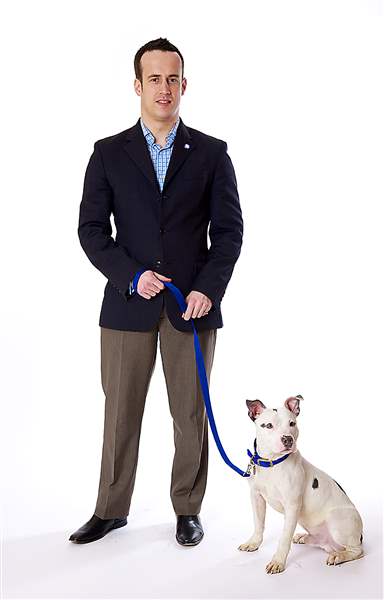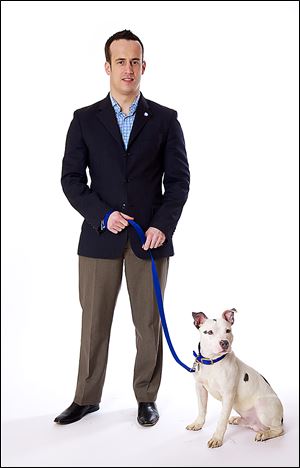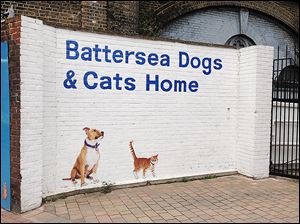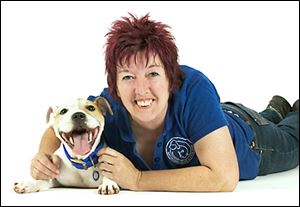
DOG LAWS
Animal advocates fight U.K. ‘breedism’
British rules, kill rates what Ohio’s had been
5/12/2013
‘Nice dogs are being put to sleep for nothing other than what they look like,’ says Rob Jervis-Gibbons, public affairs and policy manager of Battersea Dogs and Cats Home, England’s largest animal welfare group.
BATTERSEA

‘Nice dogs are being put to sleep for nothing other than what they look like,’ says Rob Jervis-Gibbons, public affairs and policy manager of Battersea Dogs and Cats Home, England’s largest animal welfare group.
LONDON — Great Britain’s breed-specific dog law has “failed miserably” in protecting the public, much like similar legislation which was repealed in Ohio last year, according to an animal welfare expert.
Battersea Dogs and Cats Home euthanized 155 banned dogs last year — 121 which were “pit bull”-type dogs — based solely on their appearance, said Rob Jervis-Gibbons, public affairs and policy manager at Battersea, England’s oldest and largest animal welfare group.
“It’s really hard for us,” he said. “Nice dogs are being put to sleep for nothing other than what they look like. It’s ‘breedism,’ pure and simple.”
Dog legislation officers, who are employed by the police, regularly visit all animal rescue groups to decide which dogs are illegal and must be euthanized.
“We are obliged under U.K. law to put these dogs to sleep,” Mr. Jervis-Gibbons said. “Ninety-four percent of these dogs had a good temperament and posed no threat to the public.”
The nonprofit group, which receives no government funding, cared for 5,221 dogs and 2,760 cats in 2012. Battersea cares for an average of 400 dogs and 190 cats across its three centers at any time.
Battersea’s overall euthanasia rate in 2012 was 28 percent, Mr. Jervis-Gibbons said. Besides the illegal breeds, the shelter also euthanizes dogs of all breeds that are healthy but are judged to be too much of a risk to be offered to the public for new homes because of their temperament or behavior, he said.
Dangerous dogs?

Battersea Dogs and Cats Home has been rescuing, reuniting, and finding new homes for dogs and cats in England since 1860.
Great Britain passed the Dangerous Dogs Act of 1991 and amended it in 1997. There are four types of dogs prohibited in Great Britain: “Pit bull” terrier, Japanese Tosa, Dogo Argentino, and Fila Braziliero. None of the four is a recognized breed in England, so the word “type” is used after each, according to England’s government body in charge of the dog law, the Department for Environment, Food, and Rural Areas, also known as DEFRA.
While Great Britain singles out “pit-bull terrier type” dogs, commonly known as the American “pit bull,” it does not restrict ownership of Staffordshire bull terriers or bulldogs — both of which were considered “pit bulls” under Ohio’s former law. Rep. Barbara Sears (R., Monclova Township) introduced House Bill 14, which changed state law to no longer automatically classify “pit bulls” as dangerous dogs, in May, 2012.
Ohio’s current law states that a “dangerous” dog is one that has, unprovoked, injured a person; killed another dog; or gotten loose three or more times. A “vicious” dog is one that has seriously injured or killed a person. A “nuisance” dog, the least-severe of the three, has, unprovoked, approached a person in a menacing fashion while off its own property.
About 41 percent of the dogs that Battersea Dogs and Cats Home receive — either as strays or those surrendered by owners — are legal bull breeds, Mr. Jervis-Gibbons said. Even though they are not illegal, Staffordshire bull terriers are “misunderstood” because they look similar to the illegal type of dog.
Battersea has an elaborate marketing program called “Staffies: They’re softer than you think,” which aims to teach the public about the “loving, loyal, and reliable breed,” Mr. Jervis-Gibbons said.
“It has helped,” he said. “I personally would not have any other breed of dog. They are the best.”
‘Knee-jerk reaction’
Ali Taylor, who is the head of canine welfare training at Battersea, owns and trains both Staffordshire bull terriers and Chihuahuas. She said the Dangerous Dogs Act was a “knee-jerk” reaction to several dog attacks, ironically not by bull breeds, but by Rottweilers.

Ali Taylor, who leads dog welfare training at Battersea, says the Dangerous Dogs Act was a 'knee-jerk' reaction. The attacks weren't by bull breeds, but Rottweilers.
“Bull breeds get a bad rap,” she said. “How dogs are raised and trained is what determines their behavior, not their appearance.”
The main difference physically between the legal and illegal “pit bull” dogs is the illegal dog stands higher and has longer rear legs. Dog legislation officers carrying measuring tapes measure the dog, Mr. Jervis-Gibbons said.
According to the breed description sheet from DEFRA, the shoulder height of the “pit-bull terrier type” is 45 to 55 centimeters, which is about 18 to 22 inches. “Hips are long and broad and continue on to become relatively long hind legs with a well-muscled thigh,” according to the description.
If a dog is deemed to be one of the illegal breeds, the court has the discretion (under the 1997 amendment) to grant exemptions for seized dogs, if in its view the dogs would not compromise public safety. The court maintains an “Index of Exempted Dogs” that must meet stringent conditions, including neuter/spay, tattoo, and microchip, and the dogs must be on a lead and muzzled when in public places. Owners must maintain insurance against their dogs injuring third parties, which is extremely expensive and difficult to get.
Battersea has long campaigned for an end to breed-specific legislation, Mr. Jervis-Gibbons said.
“Whilst it is unacceptable to have dogs in the community that are a danger to society, it is equally unacceptable for the current legislation to condemn dogs by breed, regardless of their nature,” he said. “Every dog should be judged by what it has actually done, rather than what it looks like and it’s time we held irresponsible owners to account. Breed-specific legislation is not effective in tackling the real cause of the problem, which relates to the owner’s actions or omissions rather than the type of dog concerned.”
Calls for change
Parliament is in the process of revising the law to extend it to cover attacks on private property. Veterinary associations have described the revisions as a “missed opportunity” to prevent future dog attacks.
Harvey Locke, past president of the British Veterinary Association, says the government has been sent a “loud and clear” message that the Dangerous Dogs Act has failed to protect both the public and dog welfare.
“Dog welfare charities, veterinary organizations, trade unions, and enforcement bodies have been united in the call for a complete overhaul of the legislation and a new, consolidated bill to focus on prevention,” said Mr. Locke, who has been a veterinarian for more than 40 years.
The law has failed in its original intent, which was to prevent dog fighting, eradicate the pit bull terrier, and protect the public, Mr. Jervis-Gibbons said.
“Putting a healthy, good-natured dog to sleep is unacceptable for a charity that exists to rescue and rehabilitate animals,” he said. “Battersea would like to see new consolidated dog laws introduced that finally tackle irresponsible ownership and protect public safety and animal welfare.”
Missing the boat
Jean Keating, executive director of the Lucas County Pit Crew, a local “pit bull” rescue and advocacy group, who was instrumental in helping change Ohio’s former anti-“pit bull” laws, said Great Britain has “really missed the boat when it comes down to what creates dangerous encounters with dogs.”
The most effective laws are the ones that look at an individual dog’s behavior and make predictions about behavior based on past behavior, said Ms. Keating, who is also a dog trainer.
“I am always intrigued by the breeds that different people select to condemn, as there is usually no rhyme nor reason to the selection,” she said.
A dog’s behavior is related to its owner’s behavior and how he or she trains the dog, and not any certain breed, she added.
“Evidence supports the theory that the genes responsible for physical characteristics are in no way related to the genes that contribute to behavioral characteristics,” Ms. Keating said. “The most violent dogs I have ever met are the ones owned by complete idiots with anger management problems.”
She said she hopes that Great Britain, as well as other states and cities in the United States that still judge dogs based on their appearance and not their behavior, will reconsider.
“As we continue to move forward in our understanding of dog behavior and safety around dogs, I think eventually we will look back at breed discrimination and wonder how educated people could have been so incredibly ignorant,” Ms. Keating said.
Contact Tanya Irwin at: tirwin@theblade.com or 419-724-6066.